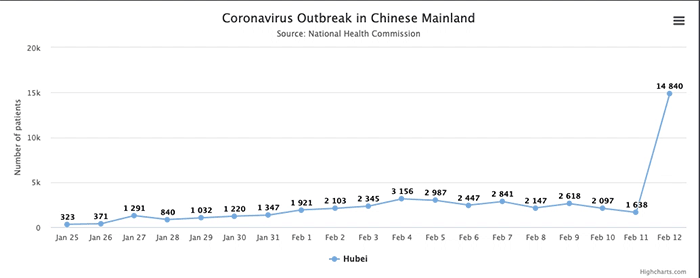‘Clinically diagnosed cases’ included in outbreak center Hubei to effectively fix a loophole in COVID-19 spread

GT
Central China's Hubei Province, the epicenter of the novel coronavirus pneumonia (COVID-19) outbreak, began to include the number of clinically diagnosed cases in its daily updated report for the first time on Thursday.
Hubei Province announced Thursday a total of 14,840 new cases, including 13,332 clinically diagnosed cases, of COVID-19 as of midnight on Wednesday.
“The announcement of more than 14,000 clinically diagnosed cases in Hubei is good news, which would fix some previous loopholes in the epidemic control work and make the admission of patients more convenient, and enable them to get timely treatment,” Zeng Guang, chief epidemiologist with the Chinese Center for Disease Control and Prevention (CCDC), told the Global Times on Thursday.
According to the latest official action plan for COVID-19 diagnosis and treatment released by the National Health Commission (NHC) on Saturday, Hubei Province is required to include "clinical diagnosis," based on features of pneumonia, in its case diagnosis classification. This is different to requirements in other parts of the country.
Cases of clinical diagnosis will first be quarantined. Patients with severe or critical symptoms will be transferred to designated hospitals. Patients with mild pneumonia will go to one of the makeshift hospitals, said the Wuhan Health Commission on Thursday.
The term "clinically diagnosed case" refers to cases with clinical symptoms similar to those of confirmed cases, though lab tests have yet to determine an infection.
This means that a suspected case will be clinically diagnosed as long as the patient shows pulmonary lesions typical of the new coronary pneumonia following a CT scan, even if they have not been given a nucleic acid test, Xiang Hao from School of Health Science at Wuhan University told the Global Times on Thursday.
Such a surge in the number of clinically confirmed cases should be a "release of stock," and there will be more confirmed cases in the future, but it will not necessarily remain so high, Yang Gonghuan, former deputy head of the CCDC, told the Global Times Thursday.
"But we should be a little bit relieved with that number, as it indicated that some of the sources of infection have actually been identified and isolated,” Yang said.
Huge rise in daily deaths
Hubei Province also reported 242 new deaths including 135 clinically diagnosed cases of COVID-19 as of midnight Wednesday. The previous day recorded only 94 new deaths in Hubei.
Experts believed the sharp increase in deaths potentially has resulted from the adjustment of diagnostic criteria and the previous accumulation of cases, especially those in critical condition, but they said that further explanations from the Hubei provincial government are needed.
Wang Peiyu, a public health professor at Peking University, told the Global Times on Thursday that including the number of clinically diagnosed cases in the total of newly confirmed cases means that Hubei has adjusted the diagnostic criteria, turning some cases previously deemed as suspected ones into confirmed cases, which would also lead to a surge in the number of deaths.
Wang Guangfa, a respiratory expert at Peking University First Hospital, told the Global Times that the increase in the number of confirmed cases and deaths in Hubei could also be caused by problems in technical aspects of clinical diagnosis, as some doctors may not have fully understood the clinical diagnostic criteria and only relied on CT scans.
Wang called for strengthened training for doctors regarding diagnostic criteria and accurate CT scan analysis.
Yang Zhanqiu, director of the pathogen biology department at Wuhan University, told the Global Times on Thursday that the increase in the number of deaths also showed that there are no drugs that can cure the disease, and previously admitted patients were critically ill with no effective treatment.
Priority of priorities
Headed by Premier Li Keqiang, the Leading Group of the CPC Central Committee for Novel Coronavirus Prevention and Control urged at a Thursday meeting to continue to view Hubei Province, and Wuhan in particular, as the priority of priorities, and that Wuhan should pick up its speed to collect, admit and provide quarantine and medical treatment for the four-type personnel.
The leading group also urged that other parts of Hubei Province, including Xiaogan and Huanggang, should also take measures equivalent to those in Wuhan.
Official data NHC released on Thursday, as of the end of Wednesday, the number of new confirmed cases discovered outside Hubei Province has decreased for nine consecutive days, dropping from 890 on February 3 to 377 on Tuesday and to 312 on Wednesday.
Guo Yanhong, an official with the NHC told at the daily press conference on Thursday that a total of 5,911 infected people had been discharged from hospital after their recovery by the end of Wednesday, and each day since February 7 has seen some 500 recovered patients walk out of hospital.
Also, a preliminary analysis of 596 discharged cases found that about 90 percent of the cured patients had mild symptoms while 10 percent were those in severe or critically ill condition, she noted, “meaning that even severe and critically ill patients can be cured.”
At present, since there is no breakthrough finding in regards to the source of the epidemic, routes of transmission and particularly effective drugs, huge uncertainties still remain regarding epidemic prevention and control, experts said.
In response to the news on that a lab team led by Chinese government top medical advisor Zhong Nanshan announced detecting live new coronavirus in the feces of a patient in a critical condition, Mi Feng, spokesperson of NHC said on Thursday that it does not suggest a change to the virus’s primary transmission method.